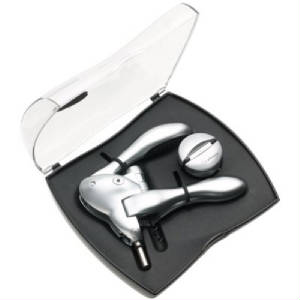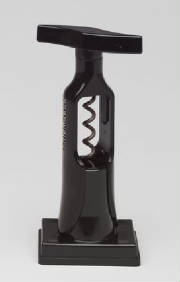|
A few years ago my wife presented me with a high tech cork
screw for Father’s Day. What else do you get a wine drinking gadget guru? It’s a Rabbit (manufactured by Metrokane), so-named presumably because of its
sleek outline that resembles a bunny with long floppy ears. The device
really works effortlessly and reliably removing corks but what really impresses me is that its simple operation is just so damn elegant. Of course as a self-confessed gadget junkie
I’m predisposed to such things and I suppose I see and appreciate elegance in the mechanical world that others may not
share. But even the most hardened luddites have been overheard to remark on its
coolness factor.
| The Rabbit Corkscrew |

|
So
while opening a bottle of Shiraz last night I wondered about the back story behind this device. The corkscrew is, I admit, a limited tool. You don’t
need it often or for a variety of tasks but when you need one its pretty invaluable. That’s
why no self-respecting Swiss Army Knife is without one. The corkscrew is a relatively
crude but (in literal terms) complex machine – the kind you study about in sixth grade science. It works by combining four of the six categories of simple machines, i.e., a screw, (which in turn is made of an inclined plane in the round with
a wedge at its tip), to reduce the force required to insert the device into the
cork, coupled with a lever to assist in reducing the force needed to pull the cork
from the bottle. The other two types of simple machines in case you are
still dusting off the memories of your elementary school science curriculum are the pulley
and wheel and axle.
Corkscrews
have been around in one form or another for hundreds of years:
"It is unknown when and who made the
first corkscrew. The first corkscrews were derived from a gun worme, a tool with a single or double spiral end fitting used
to clean musket barrels or to extract an unspent charge from the barrel. By the early 17th century corkscrews for
removing corks were made by blacksmiths as using a cork to stopper a bottle was well established."*
*Corkscrew
historian Ron McLean from the "The Virtual Corkscrew Museum", The History of the Corkscrew, http://inventors.about.com/library/weekly/aa122000a.htm
|
 |
|
|
|
 |
|
And since those first designs there have been
several notable innovations including the single lever “Waiter’s Friend” patented in 1882 (fits easily in
a pocket, works well, but requires some finesse), the double winged lever found in most households first developed in 1888
(clunky, usually works but sometimes requires some last ditch pulling), and The Walker Bell corkscrew
patented in 1893 by Edwin Walker, an American designer. This wood handled gizmo is the one I remember my parents using growing
up – it has a bell shape that rests on the neck of the bottle and when you twist the wooden handle it forces the cork
out without lifting (nice idea but needs lots of muscle). Following the flurry
of technical innovation at the end of the 19th century it wasn’t until almost 100 years later that someone
thought we needed a better mousetrap.
It turns out that the Rabbit is essentially a copy of a design
pioneered by Herbert Allen, a successful Texas oil and gas engineer (and wine connoisseur) who began work on the Screwpull
line of corkscrews in 1975. As the story goes, one evening his wife had difficulty
removing the cork from a bottle of wine and after trying numerous devices basically challenged her husband to come up with
a more effective technique. Something along the lines of,
“Honey, If you’re smart
enough to figure out how to get oil from way down deep under the ground, why can’t you figure out how to get this @%$&#!
cork out the bottle?”
| The Screwpull Table Model at MOMA |

|
So Allen set to work and several years later had perfected his
first version of the Screwpull called the Table Model which was a Teflon coated screw that is easily driven into and through
the cork while it grips the neck of the bottle and reversing the screw extracts the cork intact without pulling. The innovative, simple elegance of Allen’s initial design earned it a place in the permanent collection
of the Museum of Modern Art (MOMA) in NYC. Shortly later he came up with the
even cooler lever design on which the Rabbit is based. Screwpull Corkscrews are
marketed by La Creuset and are considered by many to be the Cadillac of corkscrews, which would then make the Rabbit a Volkswagn
of… hey, wait a minute – you don’t suppose that’s why they
gave it that name?
|
 |
|
|
|

